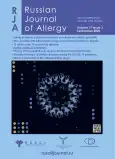The effectiveness of omalizumab in patients with severe chronic spontaneous urticaria (results of own clinical experience)
- Authors: Skorokhodkina O.V.1, Klyucharova A.R.1,2, Luntsov A.V.2
-
Affiliations:
- Kazan State Medical University
- Republican Clinical Hospital
- Issue: Vol 17, No 3 (2020)
- Pages: 74-81
- Section: Original studies
- URL: https://journals.rcsi.science/raj/article/view/121643
- DOI: https://doi.org/10.36691/RJA1379
- ID: 121643
Cite item
Full Text
Abstract
BACKGROUND: Urticaria is one of the most common dermatoses and affects 15–25% of the population; chronic spontaneous urticaria occur in 1.8% of adults and in 0.1–3% of children. Second generation antihistamines are effective only in 45–77% of patients. The next steps of treatment include increase antihistamines dose and their combination with omalizumab.
AIM: To analyze own clinical experience and assess effectiveness of omalizumab in severe chronic spontaneous urticaria.
MATERIALS AND METHODS: Effectiveness of biological treatment with omalizumab was analyzed in 14 patients with severe chronic spontaneous urticaria.
RESULTS: The prescription of omalizumab in the basic therapy of patients with severe chronic spontaneous urticaria (CSU) allowed to reduce significantly the severity of clinical symptoms in 78.6% of patients, to abandon the use of systemic glucocorticosteroids and to achieve partial or complete control of the disease. It should be noted, that 28.5% of patients during the immunobiological therapy stopped taking second-generation antihistamines and the dosage was reduced to therapeutic in 35.7% of patients.
CONCLUSION: Omalizumab is a highly effective in patients with severe chronic spontaneous urticaria.
Full Text
##article.viewOnOriginalSite##About the authors
Olesya V. Skorokhodkina
Kazan State Medical University
Author for correspondence.
Email: olesya-27@rambler.ru
ORCID iD: 0000-0001-5793-5753
head of the Department of Clinical Immunology with Allergology of Kazan State Medical University, MD, PhD, professor
Russian Federation, KazanAliya R. Klyucharova
Kazan State Medical University; Republican Clinical Hospital
Email: aliluia@yandex.ru
ORCID iD: 0000-0001-9045-5831
assistant, Department of Clinical Immunology with Allergology of Kazan State Medical University, MD, Phd, allergologist-immunologist
Russian Federation, KazanAlexey V. Luntsov
Republican Clinical Hospital
Email: luntsov@gmail.com
ORCID iD: 0000-0003-2552-2107
head of the Cеnter of Clinical Immunology, PhD, allergologist-immunologist
Russian Federation, KazanReferences
- Khaitov R.M., Il′ina N.I., editors. Allergologiya i klinicheskaya immunologiya. Klinicheskie rekomendatsii. Moscow: GEOTAR-Media; 2019. P. 214–241 (In Russ.).
- Kozel MM, Sabroe RA. Chronic urticaria: aetiology, management and current and future treatment options. Drugs. 2004;64(22):2515–2536. doi: 10.2165/00003495-200464220-00003
- Zuberbier T, Balke M, Worm M, Edenharter G, Maurer M. Epidemiology of urticaria: a representative cross-sectional population survey. Clin Exp Dermatol. 2010;35(8):869–873. doi: 10.1111/j.1365-2230.2010.03840.x
- Meshkova RY. Chronic spontaneous urticaria (part 1). Allergologiya i immunologiya v pediatrii. 2014;(1):12–17 (In Russ.).
- Kaplan AP, Greaves M. Pathogenesis of chronic urticaria. Clin Exp Allergy. 2009;39(6):777–787. doi: 10.1111/j.1365-2222.2009.03256.x
- Vonakis BM, Saini SS. New concepts in chronic urticaria. Curr Opin Immunol. 2008;20(6):709–716. doi: 10.1016/j.coi.2008.09.005
- Kolkhir P, Church MK, Weller K, Metz M, Schmetzer O, Maurer M. Autoimmune chronic spontaneous urticaria: What we know and what we do not know. J Allergy Clin Immunol. 2016;139(6):1772–1781. doi: 10.1016/j.jaci.2016.08.050
- Zuberbier T, Aberer W, Asero R, Abdul Latiff AH, Baker D, Ballmer-Weber B, et al. The EAACI/GA2LEN/EDF/WAO guideline for the definition, classification, diagnosis and management of urticaria. The 2017 revision and update. Allergy. 2018;73(7):1393–1414. doi: 10.1111/all.13397
- Criado R, Criado P, Martins J, Valente N, Michalany N, Vasconcellos C. Urticaria unresponsive to antihistaminic treatment: an open study of therapeutic options based on histopathologic features. J Dermatolog Treat. 2008;19(2):92–96. doi: 10.1080/09546630701499309
- grls.rosminzdrav.ru [Internet]. Instructions for medical use of Omalizumab [cited 2017 Jul 31]. Available from: http://grls.rosminzdrav.ru/Grls_View_v2.aspx?routingGuid=60a93da4-4a06-425a-beb2-0a5ffdd6f4b2&t (In Russ.).
- Chang T, Chen C, Lin C, Metz M, Church M, Maurer M. The potential pharmacologic mechanisms of omalizumab in patients with chronic spontaneous urticaria. J Allergy Clin Immunol. 2015;135(2):337–342. doi: 10.1016/j.jaci.2014.04
Supplementary files










